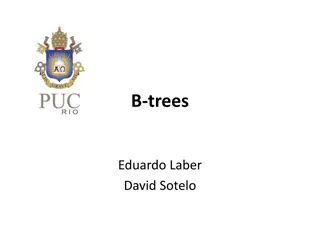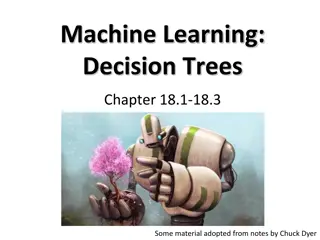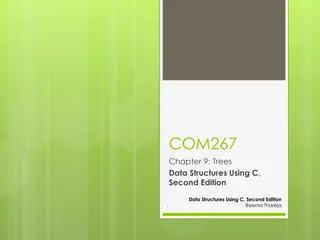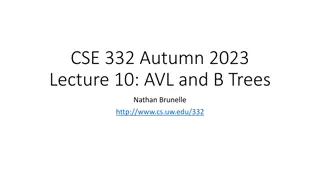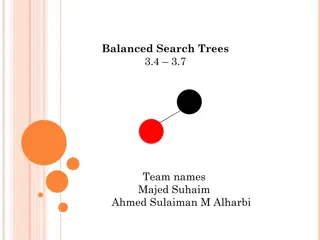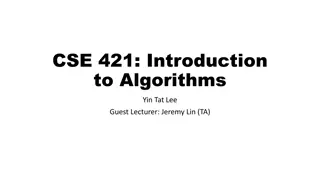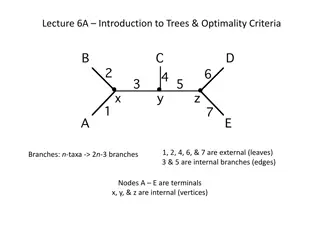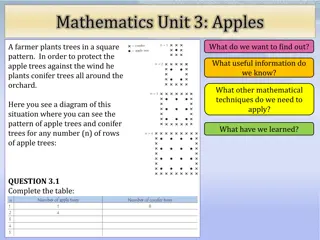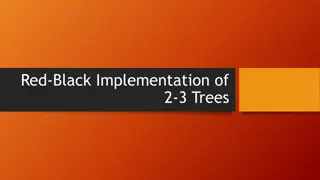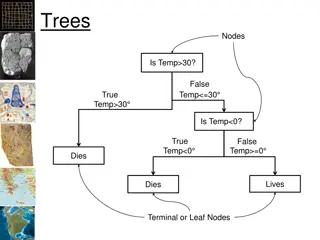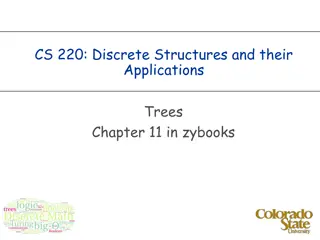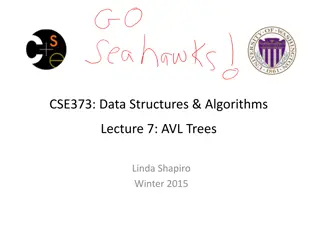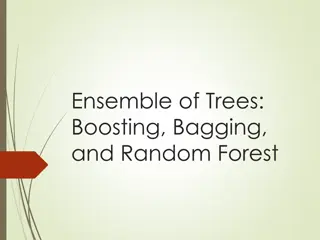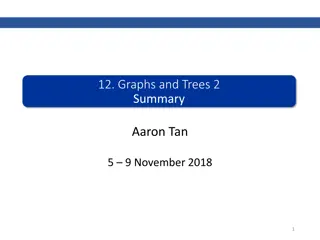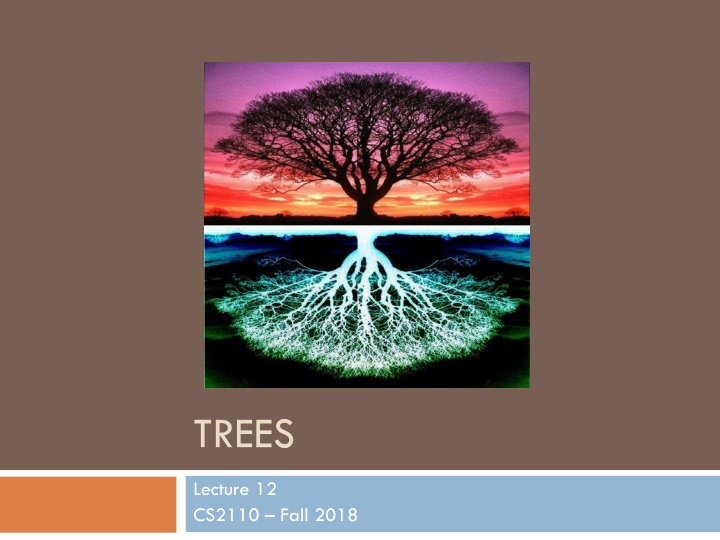
Understanding Tree Data Structures and Terminology in CS2110
Explore the world of tree data structures in CS2110, including their operations, usage, and terminology. Learn about the importance of choosing the right data structure for efficient application development and problem-solving strategies.
Download Presentation

Please find below an Image/Link to download the presentation.
The content on the website is provided AS IS for your information and personal use only. It may not be sold, licensed, or shared on other websites without obtaining consent from the author. If you encounter any issues during the download, it is possible that the publisher has removed the file from their server.
You are allowed to download the files provided on this website for personal or commercial use, subject to the condition that they are used lawfully. All files are the property of their respective owners.
The content on the website is provided AS IS for your information and personal use only. It may not be sold, licensed, or shared on other websites without obtaining consent from the author.
E N D
Presentation Transcript
TREES Lecture 12 CS2110 Fall 2018
Prelim Updates 2 Regrades are live until next Thursday @ 11:59PM A few rubric changes are happening Recursion question: -0pts if you continued to print Exception handling write the output of execution of that statement rubrics change in place
Data Structures 3 There are different ways of storing data, called data structures Each data structure has operations that it is good at and operations that it is bad at For any application, you want to choose a data structure that is good at the things you do often
Example Data Structures 4 Data Structure add(val v) get(int i) contains(val v) Array 2 1 3 0 ?(?) ?(?) ?(1) Linked List 2 ?(1) ?(?) ?(?) 1 3 0 add(v): append v to this list get(i): return element at position i in this list contains(v): return true if this list contains v AKA add, lookup, search
Tree 5 Singly linked list: 2 1 1 0 Node object pointer int value 0 2 1 Today: trees! 4 1 1 0 1
Tree Overview 6 A tree or not a tree? Tree: data structure with nodes, similar to linked list Each node may have zero or more successors (children) Each node has exactly one predecessor (parent) except the root, which has none All nodes are reachable from root 5 5 2 2 4 4 8 8 9 9 7 7 A tree Not a tree 5 5 6 4 7 8 7 Not a tree A tree
Tree Terminology (1) 7 the root of the tree (no parents) M child of M G W child of M D J P B H N S the leaves of the tree (no children)
Tree Terminology (2) 8 M G W ancestors of B descendants of W D J P B H N S
Tree Terminology (3) 9 M subtree of M G W D J P B H N S
Tree Terminology (4) 10 A node s depth is the length of the path to the root. A tree s (or subtree s)height is the length of the longest path from the root to a leaf. M depth 1 G W height 2 D J P depth 3 B H N S height 0
Tree Terminology (5) 11 Multiple trees: a forest G W D J P B H N S
Class for general tree nodes class GTreeNode<T> { private T value; private List<GTreeNode<T>> children; //appropriate constructors, getters, //setters, etc. } 12 5 <T> means user picks a type when they create one (later lecture) 4 2 General tree 7 8 9 Parent contains a list of its children 3 7 8 1
Class for general tree nodes class GTreeNode<T> { private T value; private List<GTreeNode<T>> children; //appropriate constructors, getters, //setters, etc. } Java.util.List is an interface! It defines the methods that all implementations must implement. Whoever writes this class gets to decide what implementation to use ArrayList? LinkedList? Etc.? 13 5 4 2 General tree 7 8 9 3 7 8 1
Binary Trees 14 A binary tree is a particularly important kind of tree in which every node as at most two children. 5 5 2 2 4 4 8 9 9 7 7 In a binary tree, the two children are called the left and right children. Not a binary tree (a general tree) Binary tree
Binary trees were in A1! 15 You have seen a binary tree in A1. A PhD object has one or two advisors. (Note: the advisors are the children .) David Gries Friedrich Bauer Georg Aumann Fritz Bopp Fritz Sauter Erwin Fues Heinrich Tietze Constantin Carathodory
Useful facts about binary trees 16 depth 0 2 2 0 1 0 9 5 Height 2, minimum number of nodes 2 3 8 5 Height 2, maximum number of nodes Max # of nodes at depth d: 2d Complete binary tree Every level, except last, is completely filled, nodes on bottom level as far left as possible. No holes. If height of tree is h: min # of nodes: h + 1 max #of nodes: 20+ + 2h = 2h+1 1
Class for binary tree node 17 class TreeNode<T> { private T datum; private TreeNode<T> left, right; Either might be null if the subtree is empty. /** Constructor: one-node tree with datum d */ public TreeNode (T d) {datum= d; left= null; right= null;} /** Constr: Tree with root datum d, left tree l, right tree r */ public TreeNode (T d, TreeNode<T> l, TreeNode<T> r) { datum= d; left= l; right= r; } // more methods: getValue, setValue, getLeft, setLeft, etc. }
Binary versus general tree 18 In a binary tree, each node has up to two pointers: to the left subtree and to the right subtree: One or both could be null, meaning the subtree is empty (remember, a tree is a set of nodes) In a general tree, a node can have any number of child nodes (and they need not be ordered) Very useful in some situations ... ... one of which may be in an assignment!
A Tree is a Recursive Thing 19 A binary tree is either null or an object consisting of a value, a left binary tree, and a right binary tree.
Looking at trees recursively Binary Tree 2 Right subtree (also a binary tree) 0 9 Left subtree, which is also a binary tree 3 7 8 5
Looking at trees recursively a binary tree
Looking at trees recursively value right subtree left subtree
A Recipe for Recursive Functions 24 Base case: If the input is easy, just solve the problem directly. Recursive case: Get a smaller part of the input (or several parts). Call the function on the smaller value(s). Use the recursive result to build a solution for the full input.
A Recipe for Recursive Functions on Binary Trees 25 an empty tree (null), or possibly a leaf Base case: If the input is easy, just solve the problem directly. Recursive case: Get a smaller part of the input (or several parts). Call the function on the smaller value(s). Use the recursive result to build a solution for the full input. each subtree
Searching in a Binary Tree 26 /** Return true iff x is the datum in a node of tree t*/ public static boolean treeSearch(T x, TreeNode<T> t) { if (t == null) return false; if (x.equals(t.datum)) return true; return treeSearch(x, t.left) || treeSearch(x, t.right); } Analog of linear search in lists: given tree and an object, find out if object is stored in tree Easy to write recursively, harder to write iteratively 2 0 9 We sometimes talk of the root of the tree, t. But we also use t to denote the whole tree. 3 7 8 5
Comparing Data Structures 27 Data Structure add(val v) get(int i) contains(val v) Array 2 1 3 0 ?(?) ?(?) ?(1) Linked List 2 ?(1) ?(?) ?(?) 1 3 0 Binary Tree 2 ?(?) ?(1) ?(?) 3 1 Index set by pre-determined traversal order (see slide 36); have to go through the whole tree (no short cut like array indexing) Node you seek could be anywhere in the tree; have to search the whole thing.
Binary Search Tree (BST) 28 A binary search tree is a binary tree that is ordered and has no duplicate values. In other words, for every node: All nodes in the left subtree have values that are less than the value in that node, and All values in the right subtree are greater. 5 >5 <5 8 2 3 9 0 7 A BST is the key to making search way faster.
Building a BST 29 To insert a new item: Pretend to look for the item Put the new node in the place where you fall off the tree
Building a BST 30 insert: January Note: Inserting them chronologically, (January, then February ) but the BST places them alphabetically (Feb comes before Jan, etc.)
Building a BST 31 insert: February january
Building a BST 32 insert: March january february
Building a BST 33 insert: April january february march
Building a BST 34 january february march april may june august september july october december november
Printing contents of BST 35 /** Print BST t in alpha order */ private static void print(TreeNode<T> t) { if (t == null) return; print(t.left); System.out.print(t.value); print(t.right); } Because of ordering rules for BST, easy to print alphabetically Recursively print left subtree Print the root Recursively print right subtree
Tree traversals 36 Other standard kinds of traversals preorder traversal Process root Process left subtree Process right subtree postorder traversal Process left subtree Process right subtree Process root level-order traversal Not recursive: uses a queue (we ll cover this later) Walking over the whole tree is a tree traversal Done often enough that there are standard names Previous example: in-order traversal Process left subtree Process root Process right subtree Note: Can do other processing besides printing
Binary Search Tree (BST) 37 5 8 2 3 9 0 7 Compare binary tree to binary search tree: boolean searchBT(n, v): if n == null, return false if n.v == v, return true return searchBT(n.left, v) || searchBT(n.right, v) boolean searchBST(n, v): if n == null, return false if n.v == v, return true if v < n.v return searchBST(n.left, v) else return searchBST(n.right, v) 2 recursive calls 1 recursive call
Comparing Data Structures 38 Data Structure add(val x) get(int i) contains(val x) Array 2 1 3 0 ?(?) ?(?) ?(1) Linked List 2 ?(1) ?(?) ?(?) 1 3 0 Binary Tree 1 ?(?) ?(1) ?(?) 3 2 BST 2 ?(???? ) ?(???? ) ?(???? ) 3 1
Inserting in Alphabetical Order 39 april
Inserting in Alphabetical Order 40 april august
Inserting in Alphabetical Order 41 april august december february january
Insertion Order Matters 42 A balanced binary tree is one where the two subtrees of any node are about the same size. Searching a binary search tree takes O(h) time, where h is the height of the tree. In a balanced binary search tree, this is O(log n). But if you insert data in sorted order, the tree becomes imbalanced, so searching is O(n).
Things to think about 43 What if we want to delete data from a BST? jan feb mar A BST works great as long as it s balanced. There are kinds of trees that can automatically keep themselves balanced as things are inserted! apr jun may jul


